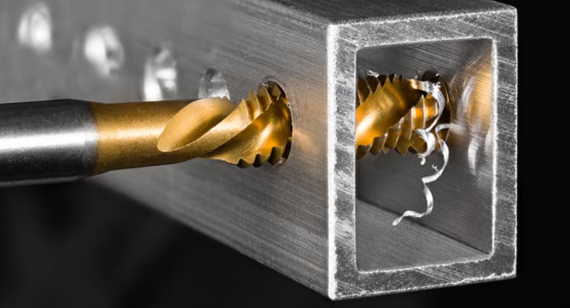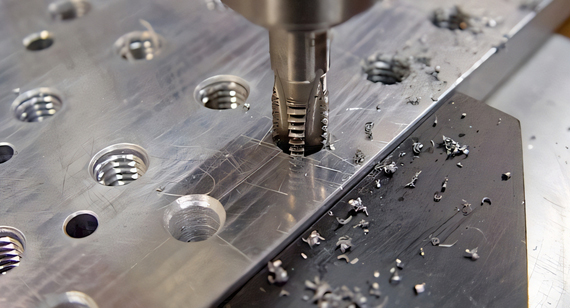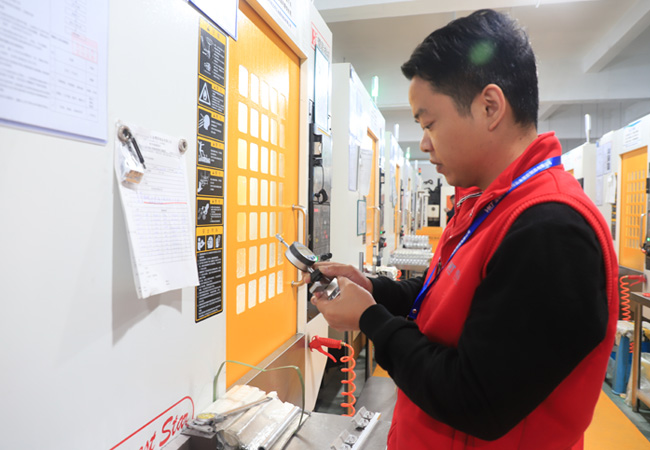Tapped Holes vs Threaded Holes | Differences Guide
In the field of CNC machining, hole machining is crucial and directly related to the performance of the product. When designing mechanical components, fasteners such as screws and bolts are often used to fix parts, and specific types of holes are required for assembly, such as countersunk holes, tapered holes, etc. Among them, Tapped Holes and Threaded Holes are two common hole processing methods, each with unique technical characteristics and application scenarios. Understanding the difference between them will help improve machining accuracy and optimize production processes.
This article will delve into the definition of tapping and threading, the use of terms, and the difference between threaded holes and tapped holes, helping you fully understand the difference between these two types of holes in CNC machining and make the best choice for a specific project.
What is Tapping?
Tapping a hole is the process of cutting an internal thread in a pre-drilled hole using a special tool called a tap. The core of this process is the use of a tapping tool, specifically a special tool called a tap. It is worth noting that tapping a hole is just another name for a threaded hole, and the two are essentially the same. Under the precise control of a CNC machine, the tap cuts a high-precision internal thread in a pre-drilled hole through rotation and feed motion, a process known as tapping.
In order to complete the tapping operation, a complete tapping kit is usually required, including taps of different specifications and types, tapping drill bits, and necessary fixtures and coolants. These kits provide a comprehensive solution for tapping metals of different sizes and materials. Drilling is an essential step before tapping, and tapping after drilling is for installing threaded fasteners such as screws or bolts.

Types of Taps Commonly Used in CNC Machining.
In CNC machining, the commonly used tap types mainly include the following:
Straight Flute Taps
Straight groove taps are the most common type of taps in CNC machining. The cutting part of the taps usually has different designs such as 2, 4, and 6 teeth. This type of tap is characterized by its strong versatility and can be used for processing through holes or non-through holes, non-ferrous metals or ferrous metals. When using it, as long as the bottom hole is deep enough, you should try to use a straight groove tap with a longer cutting cone so that more teeth can share the cutting load, thereby extending the service life.
Tip Tap
Tip taps are famous for their special front edge groove design, which makes chip removal easy, torque is small, precision is stable, and durability is good. When machining threads, chips will be discharged forward, and the core size is designed to be large, so that the tip tap can withstand greater cutting force. Therefore, the tip tap is particularly suitable for machining non-ferrous metals, stainless steel, ferrous metals and other materials, and should be used first when machining through-hole threads.
Spiral Fluted Taps
Spiral groove taps are known for their unique spiral groove design, which allows for continuous cutting, making them particularly suitable for tapping in blind holes. Compared with straight groove taps, spiral groove taps can increase cutting speed by 30% to 50%, making high-speed tapping of blind holes a good result. In addition, the cutting part of spiral groove taps is sharper, making it easier to cut into the workpiece, reducing cutting resistance and torque.
Extrusion Tap
Extrusion taps are a type of tap that forms threads by plastic deformation of metal when extruding the hole wall. This type of tap is mainly suitable for processing plastic materials such as aluminum alloys and copper, and can also process low-carbon steel and stainless steel. Since the extrusion tap does not remove material during the processing process, but squeezes it and deforms it, the internal thread formed has high finish, high precision and high strength. It is particularly suitable for processing small-size threaded holes below M6 mm, and occasions that require high-precision and high-strength threads.
How to Choose Which Type of Tap?
When choosing a tap, you need to consider multiple factors, such as the type of thread to be processed, the type of thread base hole (through hole or blind hole), the workpiece material and hardness, and the tap shape standard. The following are some common tap types and their applicable scenarios:
Straight groove tap: suitable for through hole and blind hole processing, especially for short-chip materials such as gray cast iron. Iron chips left in the tap groove may affect the thread quality.
Spiral groove tap: suitable for blind hole processing, the hole depth is generally not more than 3D. Iron chips are discharged along the spiral groove, improving the surface quality of the thread. Different helix angles are suitable for different depths, such as 10°20° for 2D depth, 28°40° for 3D depth, and 50° for 3.5D depth. It is also commonly used for through holes in hard material or large pitch processing.
Tip tap: Mainly used for through-hole processing, with an aspect ratio of 3D~3.5D. Chips are discharged downward, with low cutting torque and high thread surface quality. Suitable for plastic material processing, forming tooth profiles through plastic deformation, improving the mechanical properties and surface roughness of threads.
Extrusion tap: Suitable for processing screw holes with smaller diameters. The tooth profile is formed through plastic deformation of the material to improve the surface quality of the thread.
What is Threading?
As a key component of mechanical connection, threaded holes are the process of accurately forming continuous spiral raised internal threads on the hole wall of the material through cutting or rolling technology in CNC machining. In short, it is a hole with a specific size, pitch and shape carefully made on the material, designed to achieve a firm connection or fixation with parts such as bolts and nuts. In the CNC machining process, in order to ensure the connection reliability and stability of the threaded hole, the appropriate tap type and machining method must be strictly selected to accurately control the various parameters of the threaded hole.

Tapping vs Threading – Comparison
There are significant differences between tapping and threading in terms of processing principles, application scope and machining efficiency. Tapping mainly uses the rotation and feed motion of the tap to cut the internal thread, which is suitable for small-diameter and medium-sized thread machining. Threading, on the other hand, uses milling, turning and other methods to process threads, which is suitable for large-size and high-precision occasions. Here are their main differences:
-
Processing Principle
-
Tapping involves using a tap tool that rotates and advances into a pre-drilled hole to cut internal threads in one continuous motion.
-
Threading includes a range of techniques (such as CNC turning, CNC milling, or grinding) to cut both internal and external threads, either by single-point tools or thread mills.
-
-
Application Scope
-
Tapping is best suited for cutting internal threads in small to medium-sized holes, particularly in high-volume production where speed and simplicity are essential.
-
Threading is more versatile, capable of machining both internal and external threads, especially on larger diameters or hard-to-machine materials. It is often used where higher precision is required.
-
-
Thread Quality and Precision
-
Tapping generally offers good thread quality for standard applications, but it may struggle with high-precision or custom thread forms.
-
Threading provides higher accuracy and surface finish, making it suitable for precision-engineered components or specialized thread profiles.
-
-
Tool Life and Maintenance
-
Tapping tools may wear faster or break, especially in hard materials or deep holes, and are more sensitive to alignment issues.
-
Threading tools, especially when using single-point cutters or inserts, are easier to regrind or replace, offering longer tool life in some applications.
-
-
Machining Flexibility
-
Tapping has limited flexibility, it requires a different tap size for each thread specification.
-
Threading is more adaptable; a single-point threading tool can be used for various thread sizes and pitches with proper programming.
-
-
Machining Efficiency
-
Tapping is faster for small internal threads and is ideal for mass production.
-
Threading is slower but more precise, particularly suited for custom or low-volume components.
-
Summary Table: Tapping vs. Threading
| Aspect | Tapping | Threading |
|---|---|---|
| Processing Method | Uses tap rotation and axial feed to form internal threads in one motion | Uses milling, turning, or grinding to cut threads |
| Thread Type | Internal threads only | Internal and external threads |
| Best For | Small to medium thread sizes, high-volume production | Large diameters, custom threads, high-precision needs |
| Tool Flexibility | Requires different tap for each thread size | One tool can be programmed for various thread profiles |
| Precision | Moderate accuracy, good for standard threads | High precision, suitable for critical applications |
| Tool Life | Prone to breakage in hard materials or deep holes | Generally longer with replaceable inserts |
| Machining Speed | Fast, efficient for repetitive tasks | Slower, but more adaptable |
| Coolant Use | Essential to prevent breakage and overheating | Important, but less critical than in tapping |
In Conclusion
A threaded hole is a hole with spiral lines on the inner wall of the hole. This hole is often used to connect or fix parts such as bolts and nuts. Tapping is the process of creating internal threads, and the tap is the key tool.
Understanding the difference between tapping and threading is critical for CNC machining projects because the right choice will directly affect the efficiency and reliability of threaded hole processing. When making a decision, we need to consider factors such as material type, the type of thread required, and production quantity.

Whether it is custom CNC machined parts or mass-produced assemblies, tapping and threading are essential processes for manufacturing high-quality parts. VMT is your ideal choice for your custom CNC parts manufacturing needs.
Frequently Asked Questions About Tapped Holes and Threaded Holes
What is the Main Difference Between a Tapped Hole and a Threaded Hole?
A tapped hole is a hole in which threads are cut using a tap, and is suitable for the production of small and medium-sized threads; a threaded hole, on the other hand, is a hole in which a continuous spiral protrusion is formed on the hole wall by cutting or rolling, and is suitable for the production of large-size, high-strength threads.
How to Improve the Machining Accuracy and Efficiency of Tapped Holes and Threaded Holes?
High-quality tool materials, optimized cutting parameters, enhanced cooling and lubrication can be used to improve machining accuracy and efficiency. At the same time, advanced CNC machining technology and equipment can be used to improve production efficiency and machining quality.
What is a Tap Bolt?
A tap bolt, also commonly referred to as a headed bolt, is a type of fastener that features a head on one end and a threaded shank on the other.



